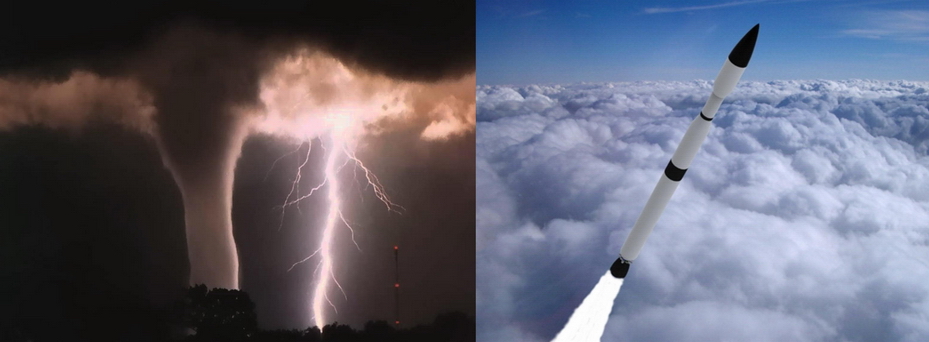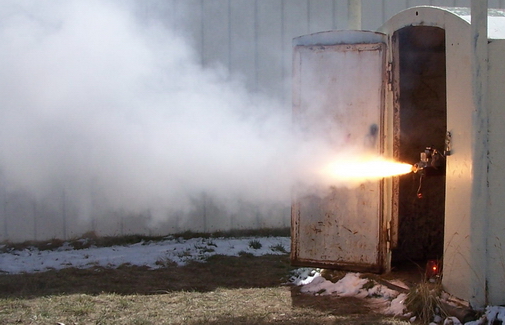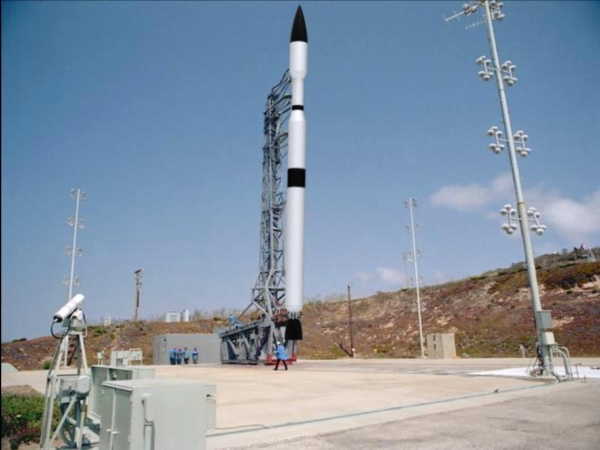
Small Launch Vehicle (SLV) - 2,000 lbs To LEO Under $5 million
Wickman Spacecraft & Propulsion Company (WSPC) has designed a responsive and low cost SLV that uses a unique solid rocket motor that gives the SLV versatile performance and low cost. The SLV’s propellant is WSPC’s high performance, environmentally friendly, low cost, phase stabilized ammonium nitrate (PSAN) space booster propellant. Its unique SLV solid rocket motors provide real time controllable thrust with a unique expansion-deflection (E-D) exit cone. The E-D exit cone concept has been verified by CFD analysis and solid rocket motor static firings. The E-D exit cone also provides optimum expansion of the exhaust gases at all altitudes. These features give WSPC’s SLV the highest level of mission versatility to deploy unmanned hypersonic vehicles or satellites.
During the SLV’s development, WSPC tested critical SLV components with bench testing and static motor firings. Static firings have demonstrated complete real time throttling capability. WSPC’s unique thrust vector control system does not vector the nozzle or exit cone, both are fixed during motor operation. Static firings have demonstrated thrust vector angles beyond what flexseals and liquid injection TVC systems can achieve.

Low Cost & Technical Innovation
Wickman Spacecraft & Propulsion Company (WSPC) is a pioneer in the area of low cost launch vehicles. The key to launch cost was identified as lowering the cost in three critical areas, (1) propulsion, (2) guidance and control and (3) launch site operations. In order to be successful in reducing launch costs, all three of these areas must experience cost reduction from present levels.
The initial focus of WSPC’s work was to develop low cost propulsion systems. This effort was started under Air Force contract to develop a PSAN solid propellant oxidizer and a propellant formula that could successfully make full use of it. A co-founder of the company, Dr. Adolf Oberth, was successful in both of these regards. When Dr. Oberth retired, Mr. Wickman continued his research by refining the propellant formula until it was possible to mix and cast the propellant without vacuum or curing ovens, yet obtain a propellant quality equal to vacuum casting. The propellant consists of WSPC’s PSAN-I ammonium nitrate, magnesium powder, HTPB binder and a plasticizer. The plasticizer thins out the propellant for easy mixing in a non-propellant commercial mixer. The resultant propellant is ready to pour for casting the solid rocket motor.

WSPC Small Launch Vehicle Features
All Solid Propellant SLV
- Always ready to go on a moments notice
- No fuel or oxidizer support vehicles and/or tanks
- No dangerous venting of fuel or oxidizer vapors
- No pressurized helium, LOX or fuel tanks to endanger ground crews
- Low levels of manpower to launch SLV
- All weather capability – Solids demonstrated in all weather conditions around the world
WSPC’s PSAN Solid Rocket Propellant Reduces Production Cost
- No vacuum mixing or casting eliminates need for expensive mixers and casting fixtures
- No oven cure eliminates need for expensive curing ovens
- Non-toxic, non-detonable propellant ingredients means less expensive production equipment
WSPC’s PSAN Solid Rocket Propellant Reduces Launch Cost
- Minimal environment impact – No hydrochloric acid in the exhaust
- Non-corrosive exhaust extends life of launch support equipment
- Safe, non-detonable solid propellant – Can be hit repeatedly with a hammer without ignition or explosion.
- Excess propellant can be reduced to a non-toxic oxide with water
- Eliminates environmental processing costs associated with AP propellant
- Propellant is non-toxic to the touch with no hazardous vapors
New Type Of Expansion-Deflection Exit Cone
- Optimum thrust at all altitudes of operation
Real Time Control Of Throat Area
- Real time thrust level control
- Provide thrust vector angles potentially up to 22 degrees with fixed nozzle and exit cone
- Provide thrust termination without explosive ordinance
- Provides self destruct of vehicle without explosive ordinance